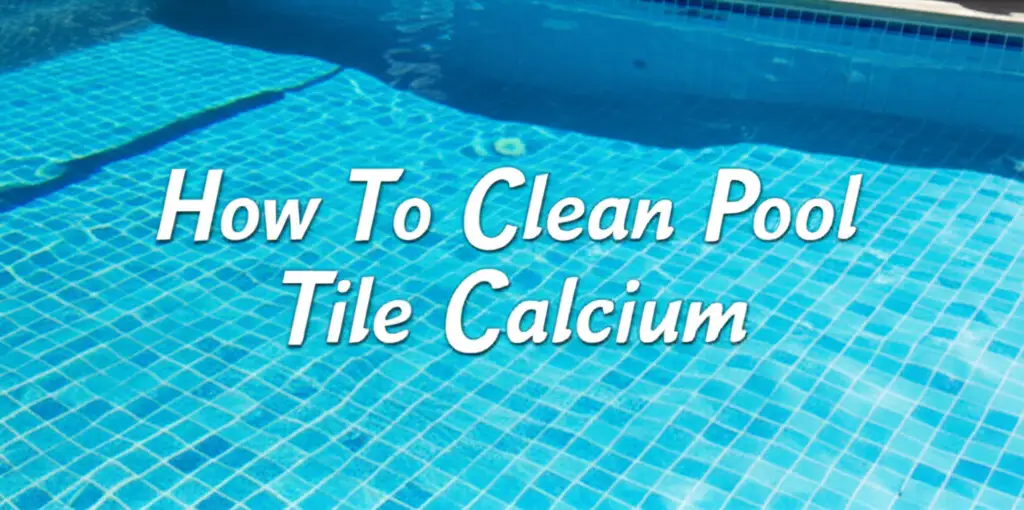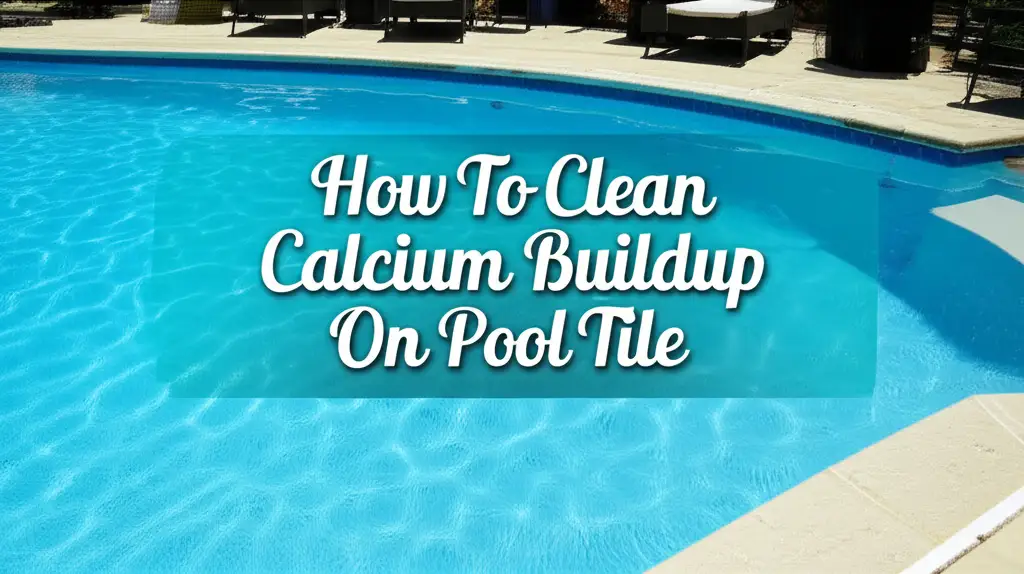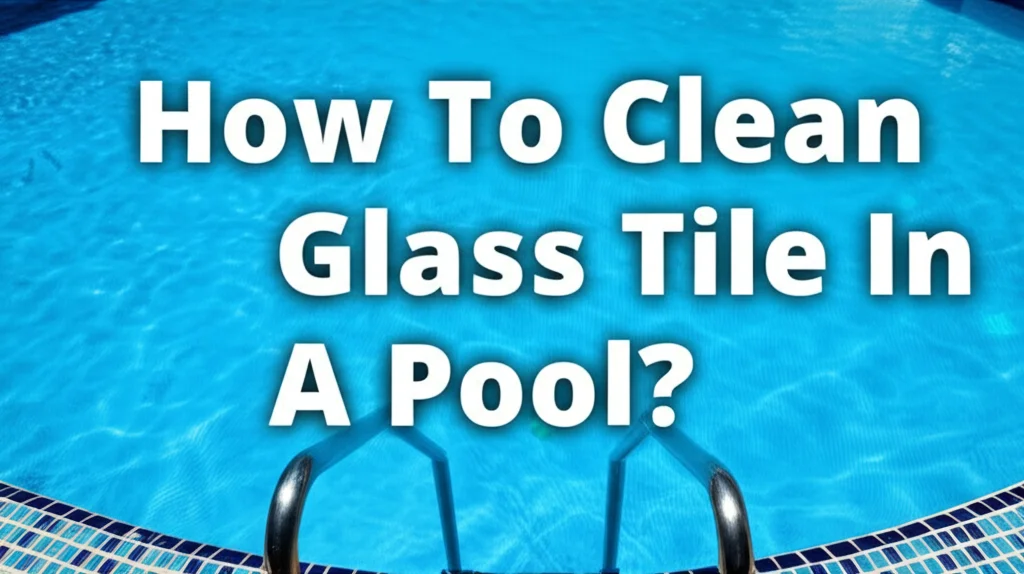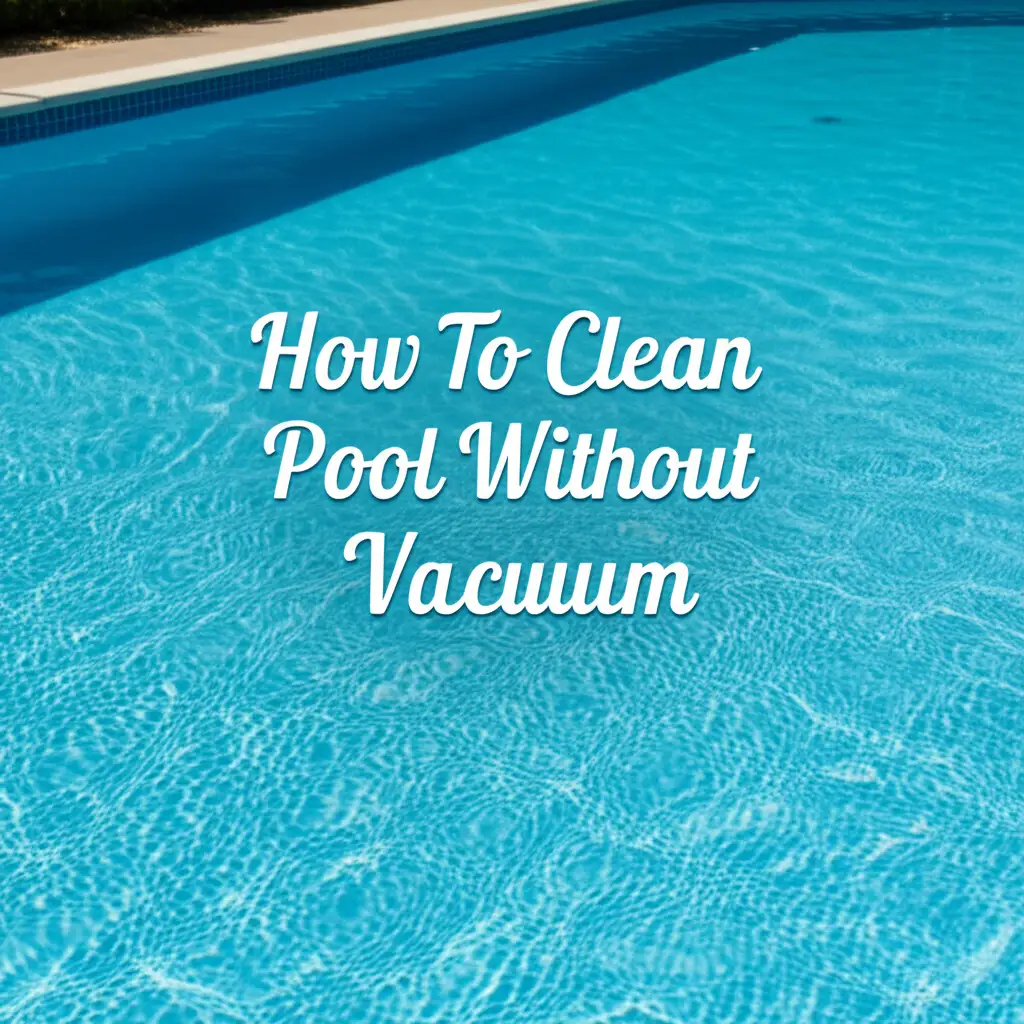· Pool Maintenance · 13 min read
How To Clean Pool Tile With Muriatic Acid
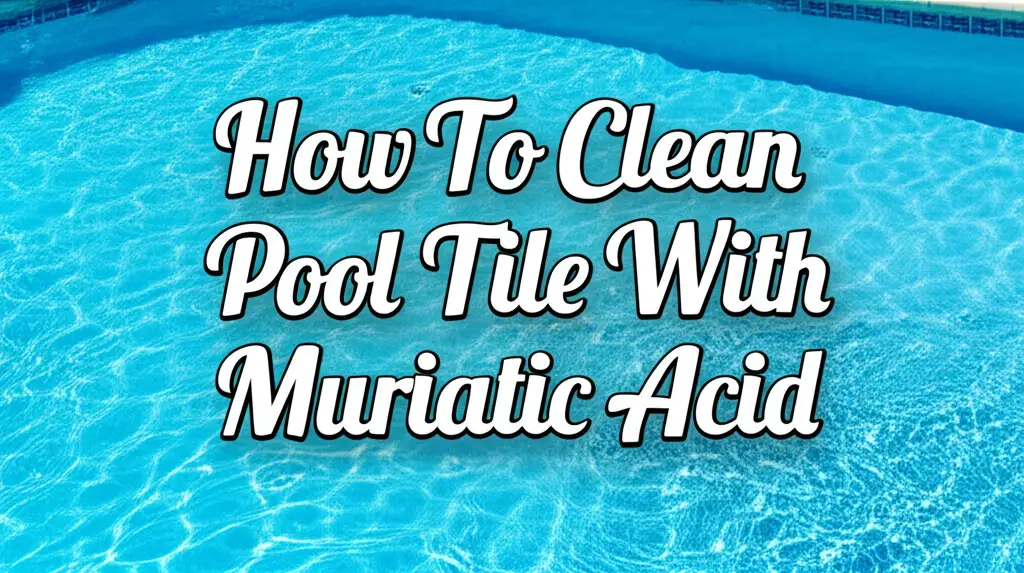
Safely Clean Pool Tile With Muriatic Acid
Dirty pool tiles can ruin the look of an otherwise beautiful swimming pool. Hard water stains, calcium buildup, and algae leave unsightly rings around your waterline. I know the frustration of seeing a film develop on my pool’s pristine surfaces. Many common cleaners simply do not remove these tough mineral deposits.
Cleaning pool tile with muriatic acid provides a powerful solution. This chemical effectively dissolves stubborn stains. It restores the original shine of your pool’s tile. However, muriatic acid is a strong chemical. It requires careful handling and strict safety measures.
This comprehensive guide helps you understand the process. We cover everything from preparing your workspace to applying the acid safely. You will learn how to achieve sparkling clean pool tiles and maintain them.
Takeaway
- Always wear full personal protective equipment (PPE) when working with muriatic acid.
- Ensure proper ventilation in your work area.
- Dilute muriatic acid correctly by adding acid to water, never the reverse.
- Work in small sections and rinse thoroughly after each application.
- Neutralize any spills with baking soda or soda ash immediately.
To clean pool tile with muriatic acid, you first lower the pool water level below the tile line. Then, you prepare a diluted acid solution, typically 10:1 water to acid, while wearing full protective gear. Apply the solution to small tile sections, scrub thoroughly, and rinse completely with water, neutralizing any acid residue.
Understanding Muriatic Acid for Pool Tile
Muriatic acid is a common name for hydrochloric acid. It is a highly corrosive chemical. People use it often for various cleaning tasks. It is especially effective at dissolving mineral deposits. This makes it a popular choice for cleaning pool tiles. I use it for the toughest stains.
Pool tiles frequently develop calcium and hard water stains. These white or grayish crusts cling stubbornly to surfaces. Normal scrubbing or mild detergents do not remove them. Muriatic acid reacts chemically with these mineral deposits. It breaks them down into soluble compounds. This allows for easy rinsing. This acid is very strong. Its power demands respect and caution. It can cause severe burns if it touches skin. It also creates irritating fumes. Understanding its properties is the first step toward safe use. We must prioritize safety over speed.
Many pool professionals use muriatic acid for deep cleaning. It removes scale that builds up over time. This scale can harbor algae and bacteria. Cleaning it improves pool hygiene. It also helps your pool look its best. Always remember that this is a powerful tool. Use it only when necessary and with extreme care. My experience shows that proper preparation prevents problems.
Essential Safety Measures Before You Start
Working with muriatic acid requires strict safety precautions. This chemical can cause serious harm if misused. Your personal safety is the most important part of this job. I always emphasize this point with anyone considering this task. Never rush the preparation steps.
First, wear full personal protective equipment (PPE). This includes acid-resistant gloves. You also need safety glasses or goggles. A face shield provides additional protection. Wear long sleeves and pants. Use old clothes you do not mind damaging. A respirator mask with acid vapor cartridges is crucial. It protects your lungs from harmful fumes. Proper ventilation is also vital. Work outdoors on a breezy day if possible. Avoid enclosed spaces. If working in a screened enclosure, ensure good airflow. Cleaning algae from your pool screen enclosure might be a different job.
Always have a neutralizing agent ready. Baking soda or soda ash works well. Keep a large box nearby. You can sprinkle it directly on spills. It stops the acid’s corrosive action. Have a hose with running water nearby too. If acid splashes on your skin or eyes, rinse immediately for at least 15 minutes. Seek medical attention if a splash occurs. Never mix muriatic acid with other cleaning products. This includes chlorine bleach. Mixing can create dangerous gases. Be mindful of every action you take.
Gathering Your Tools and Supplies for Pool Tile Cleaning
Before you begin the cleaning process, collect all necessary tools and supplies. Having everything ready saves time and ensures a smooth operation. It also prevents you from needing to stop mid-task. I find that a well-organized workspace makes any cleaning project easier.
Here is a list of what you will need:
- Muriatic Acid: Purchase a fresh bottle from a pool supply store or hardware store.
- Large Plastic Buckets: You need at least two. One for the acid solution, one for rinse water.
- Plastic Measuring Cups: Use these for precise dilution. Do not use metal cups.
- Stiff, Acid-Resistant Brush: A tile brush or a pool brush with acid-resistant bristles works well.
- Smaller Scrub Brush: This is good for tight corners or intricate tile designs.
- Plastic Sprayer Bottle: If you prefer spraying the solution onto the tiles.
- Wet/Dry Vacuum (Optional): Useful for quickly removing water from specific areas.
- Neutralizing Agent: Baking soda or soda ash.
- Garden Hose with Nozzle: For rinsing the tiles thoroughly.
- Personal Protective Equipment (PPE): As listed in the previous section – gloves, safety glasses, face shield, respirator, old clothes.
- Plastic Pump: To lower the water level if your pool does not have a drain.
Ensure all containers and tools are made of plastic or other acid-resistant materials. Metal will corrode when exposed to muriatic acid. I always double-check my equipment before starting. This preparation prevents unexpected issues during the cleaning process.
Step-by-Step Guide to Cleaning Pool Tile with Muriatic Acid
Cleaning pool tile with muriatic acid requires a precise approach. Follow these steps carefully to ensure effectiveness and safety. I break down the process into manageable stages. This helps ensure each part is done correctly.
Preparing the Pool Water Level
First, lower your pool’s water level. The water must be below the lowest affected tile line. This ensures you can access all the stained areas. If your pool has a main drain, you can use that. Otherwise, a submersible pump works well. Make sure you drain the water to a safe location. Avoid draining directly into storm drains. Consider draining into your yard if it won’t flood or harm plants. This step prevents the acid from mixing with your main pool water during application.
Diluting Muriatic Acid Safely
Always add acid to water, never water to acid. This rule prevents dangerous chemical reactions and splashes. I use a ratio of 10 parts water to 1 part muriatic acid for general cleaning. For very stubborn stains, you can go as strong as 1 part water to 1 part acid. Pour the water into your plastic bucket first. Then, slowly and carefully add the measured muriatic acid. Stir gently with a plastic stick. Wear all your PPE during this step. This is where most accidents happen.
Applying and Scrubbing the Tiles
Work on small sections of tile at a time. This allows you to control the acid and rinse effectively. Use your acid-resistant brush or sprayer to apply the diluted solution. Apply it directly to the stained tile. Let the acid sit for 30 seconds to 1 minute. Do not let it dry on the tile. The acid begins to work immediately. You will often see it fizzing as it dissolves the calcium. Then, use your stiff brush to scrub the tile vigorously. For tough spots, a smaller brush helps. Be thorough with your scrubbing.
Rinsing Thoroughly
After scrubbing each small section, rinse it immediately. Use your garden hose to flood the area with clean water. Rinse completely. Ensure all acid residue washes away. Some people prefer to lightly spray the rinsed area with a neutralizing solution (baking soda and water) before the final rinse. This ensures complete neutralization of any remaining acid. This rinsing step is critical. It prevents the acid from etching or damaging the tile grout. For effective pool maintenance, consider checking other pool components like your sand filter for above ground pool or above ground pool pump impeller once the tile cleaning is done, as part of overall pool care.
Replenishing Pool Water and Testing
Once all tiles are clean and rinsed, refill your pool. Use fresh water. After the pool fills, test your water chemistry. Pay close attention to pH and alkalinity levels. Muriatic acid lowers pH. You may need to adjust your pool’s pH and alkalinity using appropriate chemicals. This ensures your pool water is balanced and safe for swimming. Always test your water before allowing anyone to swim. This completes the cleaning process.
Dealing with Stubborn Stains and Mineral Deposits
Some stains cling to pool tiles more stubbornly than others. Calcium scale, efflorescence, and mineral deposits can be particularly challenging. They often require more focused treatment. I have encountered many such tough spots on various pools. They demand a little more patience and specific techniques.
For severe calcium buildup, you might need a slightly stronger acid solution. Instead of a 10:1 ratio, try a 5:1 or even 1:1 water-to-acid mixture. Always test a small, inconspicuous area first. This checks for any adverse reactions on your specific tile type. Apply the stronger solution directly to the thickest deposits. Allow it to dwell for a slightly longer period. Do not exceed a few minutes. Monitor the reaction closely. You should see the calcium bubbling.
After the acid works, scrub the area with your stiff brush. A non-abrasive scrubbing pad or a pumice stone designed for tile can help. Use extreme caution with pumice stones. They can scratch some tile types. Always keep the stone and tile wet. Apply gentle pressure. If the stain persists, repeat the application and scrubbing process. Multiple lighter applications are better than one overly strong or long application. Always rinse thoroughly after each attempt. Ensuring a clean tile surface is important for preventing further issues, just like knowing how to clean an above ground pool with algae helps maintain overall pool health.
Post-Cleaning Pool Tile Care and Maintenance
Once your pool tiles are sparkling clean, the work is not entirely done. Proper post-cleaning care and ongoing maintenance are crucial. These steps prevent rapid re-accumulation of stains. They also protect your newly cleaned tiles. I believe proactive maintenance saves a lot of hard work later.
First, ensure your pool water chemistry is perfectly balanced. Muriatic acid lowers the water’s pH. After refilling, test your pool’s pH, alkalinity, and calcium hardness. Adjust them as needed. Maintaining proper pH (7.4-7.6) and alkalinity (80-120 ppm) reduces the likelihood of future scale formation. Calcium hardness also plays a role. If calcium levels are too high, mineral deposits are more likely to form.
Regular brushing of your pool tiles helps immensely. Incorporate it into your weekly pool maintenance routine. A soft-bristle pool brush can dislodge early mineral deposits before they harden. This simple act prevents many headaches. Also, ensure your pool’s filtration system runs efficiently. A good filter removes particles that contribute to stains. Regularly clean your sand filter for above ground pool and check your above ground pool pump impeller. Clean filters mean clearer water, which means fewer new stains. These routine tasks extend the life of your tile cleaning efforts significantly.
Alternatives to Muriatic Acid for Pool Tile Cleaning
While muriatic acid is powerful, it is not always the only option for pool tile cleaning. For lighter stains or those who prefer less aggressive chemicals, several alternatives exist. I often suggest these for minor buildup or routine cleaning. They offer a safer approach for less severe problems.
One common household alternative is white vinegar. Vinegar is a mild acid (acetic acid). It can dissolve light calcium deposits and hard water stains. You can apply undiluted white vinegar to the tiles. Let it sit for 15-30 minutes. Then scrub with a stiff brush and rinse thoroughly. For a more abrasive, yet gentle, solution, a paste of baking soda and water works well. Apply the paste, scrub, and rinse. This method can remove surface grime and light mineral buildup. If you are exploring other general cleaning uses for these ingredients, knowing how to clean with vinegar and baking soda can provide many helpful tips.
Several commercial pool tile cleaners are also available. Some are acid-based, but others use different chemical compounds. Always read labels carefully. Look for cleaners specifically designed for pool tiles and calcium removal. Pressure washing can also remove loose dirt and some light stains. However, use caution. Too much pressure can damage grout or even dislodge tiles. Always start with a low-pressure setting. Increase it gradually only if needed. Remember, for severe, baked-on mineral deposits, muriatic acid remains the most effective solution. But for routine maintenance or minor issues, these alternatives can be a good starting point.
Frequently Asked Questions
Is muriatic acid safe for all types of pool tiles?
Muriatic acid is generally safe for ceramic, porcelain, and glass pool tiles. However, it is not suitable for natural stone tiles like marble or travertine. Acid will etch and damage these surfaces. Always test a small, hidden area first. Check your tile manufacturer’s recommendations.
How often should I clean pool tile with muriatic acid?
You should clean pool tile with muriatic acid only when necessary. This means when visible mineral buildup or hard water stains become prominent. This is usually once every few years. Regular brushing and proper water chemistry can extend the time between deep cleanings.
What if I get muriatic acid on my skin or eyes?
If acid splashes on your skin, rinse the affected area immediately with large amounts of water for at least 15 minutes. Remove any contaminated clothing. If it splashes into your eyes, flush them with water for at least 15 minutes while holding your eyelids open. Seek immediate medical attention.
Can I use muriatic acid for other pool cleaning tasks?
Yes, muriatic acid has other uses in pool maintenance. People commonly use it to lower pool pH levels. It also helps clean pool filters or remove stains from plaster surfaces. Always follow specific instructions for each application. Use proper dilution and safety gear for every task.
How do I dispose of leftover muriatic acid?
Do not pour leftover muriatic acid down a drain or into the environment. It is a hazardous waste. You should neutralize it first. Slowly add the acid to a large bucket of water. Then add baking soda until fizzing stops. The solution is then much safer. Follow local regulations for chemical disposal. Some areas have household hazardous waste collection sites.
Conclusion
Cleaning pool tile with muriatic acid transforms your pool’s appearance. It effectively removes stubborn calcium and mineral stains. You can restore the sparkle to your pool’s waterline. Remember, safety is paramount when working with this strong chemical. Always wear appropriate personal protective equipment. Ensure proper ventilation. Dilute the acid correctly.
By following the detailed steps in this guide, you can confidently tackle this cleaning task. From preparing your workspace to the final rinse, each stage is important. Ongoing maintenance, like regular brushing and balanced water chemistry, will help prevent future buildup. This means your hard work lasts longer. Enjoy your beautifully clean pool tiles. Your pool area will look inviting and well-maintained.
- Pool Tile Cleaning
- Muriatic Acid Safety
- Calcium Buildup Removal

